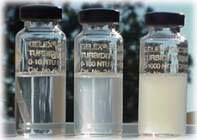
Photo from wikipedia
Presented here is a new bench-top research device for the measurement of the optical turbidity of natural sediment-laden water samples. This prototype device employs 18 unique angular measurement positions and… Click to show full abstract
Presented here is a new bench-top research device for the measurement of the optical turbidity of natural sediment-laden water samples. This prototype device employs 18 unique angular measurement positions and a variety of user-selectable LED light sources. The motivation for this project was the need to generate more parameter-rich data sets pertaining to the light-scattering properties of natural sediment suspensions, and to address the issues raised by Kitchener et al. (2017) concerning the inconsistent calibration methodologies currently employed to quantify suspended sediment concentration (SSC) by optical turbidity measurement. The mechanical design comprises re-purposed waste plastic materials and 3D-printed parts. The active light-source control and monitoring hardware and firmware executes on the open-source Arduino embedded microcontroller platform. The modular light sensors plug into any of the angular measurement positions, providing a 0–5 V nominal output signal, which is readable by the user's choice of data-acquisition system. The device will facilitate the highly detailed characterization of suspended sediment samples, providing 18 voltage output channels for analysis by the user. The precise calibration of the light sensors is by the use of neutral density (ND) filters in conjunction with light-source electrical current measurements, providing light-source intensity values as required. The empirical data provided by existing turbidity meters are acquired using incommensurate methodologies, and therefore they are not cross-comparable. A new methodology, described here, facilitates the cross-comparability of turbidity measurements.
Journal Title: HardwareX
Year Published: 2019
Link to full text (if available)
Share on Social Media: Sign Up to like & get
recommendations!